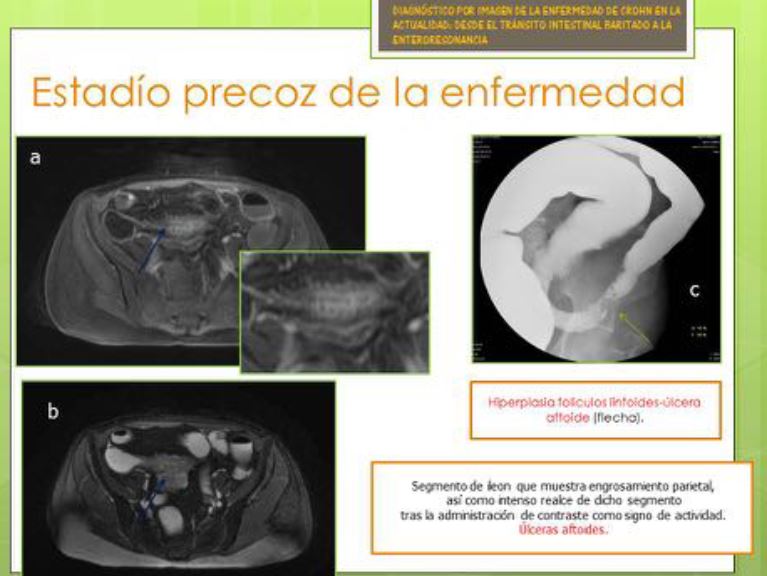DIAGNÓSTICO POR IMAGEN DE LA ENFERMEDAD DE CROHN EN LA ACTUALIDAD:
DESDE EL TRÁNSITO INTESTINAL BARITADO A LA ENTERORESONANCIA.
Palabras clave:
poster, seram, ENTERORESONANCIA, ENFERMEDAD DE CROHNResumen
Objetivos Docentes
1. Describir los signos radiológicos en la enfermedad de Crohn, tanto en fase de actividad como signos de cronicidad y sus posibles complicaciones, mediante dos pruebas de imagen como son el tránsito intestinal y la enteroresonancia (enteroRM).
2. Reconocer la enteroRM como prueba radiológica de elección en el estudio de la fase aguda y seguimiento de la EC.
Revisión del tema
El diagnóstico y sobre todo el seguimiento de la enfermedad de Crohn han experimentado cambios importantes en los últimos tiempos debido a la extensa utilización de la enteroRM.
Hasta hace relativamente poco tiempo, tanto el diagnóstico radiológico como el seguimiento de la enfermedad de Crohn se basaban en el tránsito intestinal baritado. Sin embargo, la enteroRM ha tomado relevo con fuerza, ya que valora de forma fiable la presencia o no de actividad inflamatoria y la enfermedad extramural. Además, como no utiliza radiaciones ionizantes, está especialmente indicada para pacientes jóvenes que deben realizarse controles frecuentes
Descargas
Citas
Tolan D, Greenhalgh R, Zealley I, Halligan S, Taylor S. MR Enterographic manifestations of small bowel Crohn disease. RadioGraphics 2010; 30:367–84.
Leyendecker J, Bloomfeld R, DiSantis D, Waters G, Mott R, Bechtold R. MR Enterography in the Management of Patients with Crohn Disease. RadioGraphics, 2009, Vol. 29: 1827–46.
Sinha R, Rajiah P, Murphy P, Hawker P, Sanders S. Utility of High-Resolution MR Imaging in Demonstrating Transmural Pathologic Changes in Crohn Disease. RadioGraphics, Oct 2009, Vol. 29: 1847–67.
Levine M, Rubesin S, Laufer I. Pattern approach for diseases of mesenteric small bowel on barium studies. Radiology, Nov 2008, Vol. 249: 445–60.
Lee S, Kim A, Yang S, Chung J, Kim S, Park S, Ha H. Crohn disease of the small bowel: comparison of CT Enterography, MR Enterography, and small-bowel follow-through as diagnostic techniques. Radiology, Jun 2009, Vol. 251: 751–61.
Towbin A, Sullivan J, Denson L, Wallihan D, Podberesky D. CT and MR Enterography in Children and Adolescents with Inflammatory Bowel Disease. RadioGraphics, Nov 2013, Vol. 33: 1843–60.
Rimola J, Rodríguez S, García-Bosch O, Ricart E, Pagès M, Pellisé M, Ayuso C, Panés J. Role of 3.0-T MR Colonography in the Evaluation of Inflammatory Bowel Disease. RadioGraphics, May 2009, Vol. 29: 701–19.
Allen B, Leyendecker J. MR Enterography for assessment and management of small bowel Crohn disease. Radiologic Clinics of North America, Volume 52, Issue 4, July 2014, Pages 799-810.
Maglinte D, Gourtsoyiannis N, Rex D, MD, Howard T, Kelvin F. Classification of small bowel Crohn’s subtypes based on multimodality imaging. Radiol Clin N Am 41 (2003) 285–303.
Torregrosaa A, Pallardóa Y, Hinojosab J, Insaa S, Molinaa R. Enterografía por resonancia magnética: técnica e indicaciones. Hallazgos en la enfermedad de Crohn. Radiología Volume 55, Issue 5, 10 September 2013, Pages 422–30.
Herraiz L, Alvarez E, Carrascoso J, Cano R, Martínez de Vega V. Entero-resonancia magnética: revisión de la técnica para el estudio de la enfermedad de Crohn. Radiología, Volume 53, Issue 5, September–October 2011, Pages 421-33.


